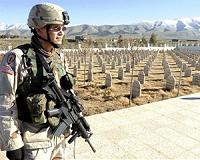| . |  |
. |
A Us Army Base, Kuwait (AFP) Aug 21, 2010 The US army has nearly completed the largest logistics operation since World War II in pulling thousands of combat troops and more than one million pieces of equipment out of Iraq, a senior officer said. "Its the largest drawdown since World War II," Colonel Donnei Walker, commander of the First Sustainment Brigade, US Third Army, said at a key US military facility in Kuwait through which most of the equipment has passed. "We have moved out nearly 1.2 million pieces of equipment," since the operation began more than a year ago, Walker told reporters during a tour of the facility in southern Kuwait on Friday. The base's name was withheld for security reasons. Walker, whose brigade is responsible for transporting materiel, was inspecting a new transportation convoy preparing to leave for Iraq to pick up a new shipment. The pullout is scheduled to be completed by the end of August. Each convoy normally consists of 40 vehicles of heavy equipment transporters, well-fortified large trucks and several armoured vehicles that provide protection. The equipment included thousands of tanks, different kinds of other military vehicles, repair parts and general supplies. The brigade is part of the First Theatre Sustainment Command (TSC), Third Army, which has been responsible for the massive logistics operations for the wars in Iraq and Afghanistan. At another location on the massive base, a second convoy of truck transporters carrying Mine Resistant Ambush Protected (MRAP) vehicles was just arriving from Iraq. The large trucks lined in an orderly manner and workers immediately began offloading the MRAPs. Thousands of tanks and heavy military vehicles, known by officers as pre-positioned equipment, filled a large space on the facility. The equipment is properly checked and then washed before being shipped, either back to the United States, or to Afghanistan or one of the 16 countries where the Third Army operates. During the operation "about 1,500 long-haul trucks were going to Iraq daily to load stuff," the deputy commander of First TSC in Kuwait, Brigadier General Nick Tooliatos, told reporters. Part of the equipment had been shipped to Afghanistan, but now "the flow of forces and equipment to Afghanistan (from Iraq via Kuwait) is almost finished," and almost everything goes back to the United States, he said. The operation included moving close to 3,000 tonnes of ammunition from Iraq to Afghanistan. Colonel Gerald O'Hara, a public affairs chief, said more than 90,000 US combat troops had been pulled out during the operation that began in June 2009 and accelerated to full speed just a few weeks after the March 7 Iraqi general election. On Thursday, the United States pulled out the last combat brigade, the 4th Stryker Brigade, 2nd Infantry Division, from Iraq into Kuwait and reduced its troop numbers to 52,000. The strength of US troops in Iraq is set to drop to 50,000 by September 1, less than a third of the peak level during a 2007 "surge." "Most of the troops withdrawn from Iraq passed through Kuwait on their way back home," O'Hara told AFP. Currently, between 15,000 and 20,000 US troops are in the oil-rich emirate, which served as the launchpad for the March 2003 US-led invasion of Iraq that toppled Saddam Hussein, he said. The forces are present at Camp Arifjan, the main US army base 70 kilometres (44 miles) south of Kuwait City, and several other smaller camps in the northern desert close to the Iraqi border. O'Hara said the number of attacks on US convoys has sharply dropped to "one to two" a week and were not as serious as attacks used to be in Iraq. The colonel said the US military presence in the region following the Iraqi pullout will be decided in negotiations between Washington and its partners in the region. "Any US military presence in the region will be based upon negotiations between the US government and its partners in the region," O'Hara said. Major General Peter Vangjel, Third Army deputy commanding general, praised Kuwait for its partnership with Washington. "Kuwait has been a great partner ... and we look forward to continue our relationship with Kuwait," he said. The two states are linked by a 10-year defence pact running up until 2012.
Share This Article With Planet Earth
Related Links Iraq: The first technology war of the 21st century
 U.S. Withdrawal From Iraq: Ending Or Outsourcing The War?
U.S. Withdrawal From Iraq: Ending Or Outsourcing The War?Moscow, Russia (RIA Novosti) Aug 20, 2010 Iraqis, along with the rest of the Muslim world, have ushered in the holy month of Ramadan, hoping it will give their thoughts some refuge from worries about Iraq's future. The country is still living without a cabinet, and only God knows when it will get one. Meanwhile, the U.S. has started withdrawing combat brigades in keeping with President Barack Obama's election pledge. All combat tr ... read more |
|
| The content herein, unless otherwise known to be public domain, are Copyright 1995-2010 - SpaceDaily. AFP and UPI Wire Stories are copyright Agence France-Presse and United Press International. ESA Portal Reports are copyright European Space Agency. All NASA sourced material is public domain. Additional copyrights may apply in whole or part to other bona fide parties. Advertising does not imply endorsement,agreement or approval of any opinions, statements or information provided by SpaceDaily on any Web page published or hosted by SpaceDaily. Privacy Statement |